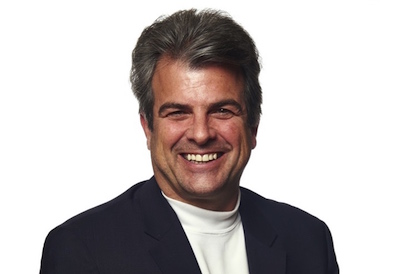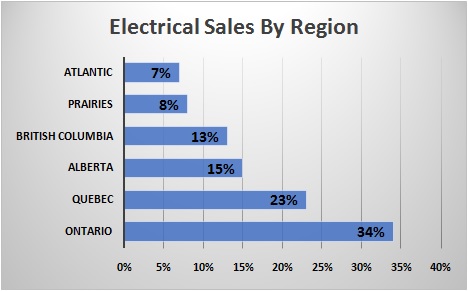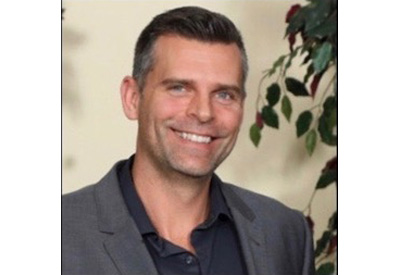Éric Deschênes — Resolutely Focused on the Digital Future

Mar 2, 2020
Line Goyette
A new figure at the head of the electrification business unit and ABB Canada, Éric Deschênes is not a newcomer to the electrical industry. A long journey that we have already highlighted by emphasizing his passion for finding practical solutions that optimize the adoption of technologies. We met with him recently to discuss his new leadership role at ABB Canada and his projects. First, he would like to point out that recent changes to ABB Canada’s structure, as elsewhere in the world, have been made to decomplex the customer relationship. “The corporate matrix has been lightened to get closer to the customer,” says Éric.
Our meeting took place at ABB’s Iberville premises, which, until recently, bore the logo of Thomas and Betts. For Éric Deschênes, this place is more than emblematic. “Thomas And Betts has brought an important signature and culture to ABB, which revolves around two axes: the distribution network and the user customer. These two elements must be at the heart of any process. Even if you offer the best product, if doing business together is difficult the customer will go elsewhere.” ABB Canada’s new CEO is now working to develop a digital platform that always situates the customer at the heart of the process.
Change is underway. The stated goal is to have a differential value in the market. “We’re competing today with people who might be in their garage. If an individual offers a product that meets a customer’s need and offers a new technology, he becomes a competitor, hence the importance of getting closer to the customer and decomplexing day-to-day relationships and business processes,” asserts Éric Deschênes, who points out that this change was initiated under the direction of Nathalie Pilon. “When Nathalie moved from the chairmanship of T-B to ABB Canada, she sought to add value and differentiate ABB by bringing all business units together. I make it my duty to continue what Nathalie has started; the change will be in continuity,” he said.
A digital shift in all internal and external processes
At the heart of these changes is an internal and external digital revolution. “We want to offer relevance and added value to the customer. We are eliminating unnecessarily long bureaucratic steps and replacing them with digital processes, and we’re seeing the processing of orders shrink from 60 days to 3 days. We also talk about VMI, online product selectors. We want to be the most effective partner for our distribution partners in terms of standard products, configuration products and engineering products.” Eric continues, “GE’s integration with ABB allows us to offer more than 20,000 standard product lines at the Bromont distribution centre. Everything is centralized for these products: an order, a shipment, a billing. When we thought about GE’s integration, the question was how to integrate this entity and move forward as a company. We started with the DNA of Thomas and Betts, aiming to become the most effective partner for our distributors, to be the most digitized and the most technical, so that we could bring relevance and added value by keeping the customer at the centre of all our processes.
“The commonality of all business units will be two-tiered digitization, both internally and externally. Internally, our factories and distribution centres are being equipped with ABB technology. At the process level, we will minimize unnecessary bureaucracy; any manual interaction that adds unnecessary pressure to a transaction will be removed. We will digitize as much as possible the interactions between people to bring unparalleled efficiency. This external digitization is ABB Ability, the digital platform that all business units will implement.”
Projects — products and assemblies in Canada
In Canada ABB has approximately 50 buildings, 9 manufacturing and assembly plants, and the Bromont distribution centre, which currently stocks only electrification products. “We will create space in the Montreal campus to make Bromont a distribution centre for products from all business units. Our customers are often the same, in automation, electrification or low voltage products. We will migrate our business systems to have a single ERP.”
The Bromont distribution centre will therefore migrate from Bromont electrification products to Bromont ABB Canada, and in the space created at the Montreal campus ABB will bring in five production lines of products formerly manufactured in the United States, including centres of motor controls, connecting panels and lighting panels. This is an important project that Éric Deschênes is committed to. “It won’t be an assembly kit. The steel will come from Canada, the manufacturing will be done in Canada, and the final assembly will be made at the Montreal campus. We successfully tested the first lighting panel that was manufactured in November and shipped to the customer; it works. We are recalibrating everything to reduce the costs of all our partners. The Canadian market has 880 distribution points, and we have access to 660 distribution points. So, it’s in our best interest to simplify and maximize to optimize. Leaving out the distributor would be a fundamental mistake in how to serve the market in Canada.”
Since Éric Deschênes and I will meet in a year’s time, I ask him now what are the goals this year that we’ll come back to in our discussion in 2021. “The No. 1 goal is to ensure that we continue to pursue the same sustained growth (greater than 10%) with the involvement of our employees. They are the ones who make the decisions, who are close to the customers. We trust them. My second objective is to accelerate internal and external digitization, and the third, the one that will give us the most pleasure, is the integration of all standard, configurable and engineering products into manufacturing processes and assembly in Canada. It’s a date!”
Line Goyette is Managing Editor of Kerrwil Publications’ Electrical Group;linegoyette@kerrwil.com
Read our profile of Éric Deschênes.











